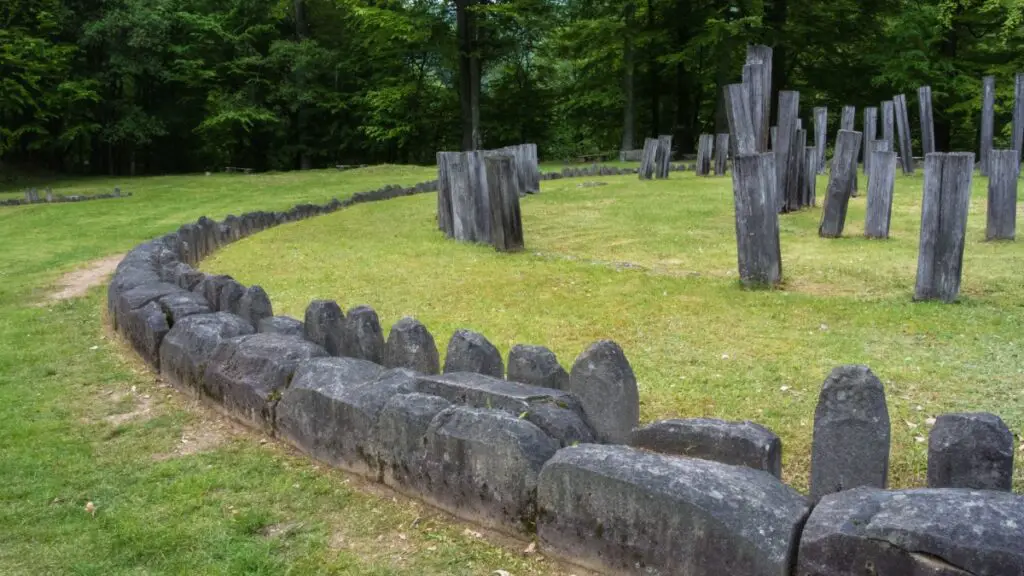This post may contain affiliate links. At no cost to you, purchases made through these links may result in a small commission for Traveling Transylvania. We never recommend products that we don’t know and trust. Thank you for your continued support!
Have you ever yearned to time-travel, not with a machine, but through an enchanting location that takes your imagination on a captivating escapade? Dive into the mystical realm of Sarmizegetusa Regia, the very heart of ancient Dacian civilization and a nexus of cultural marvels in Transylvania. Trust us; this isn’t just another historic site—it’s a passage into a bygone era where myths were born, and legends were crafted.
Wandering around Sarmizegetusa, you’re not merely taking a walk through ancient ruins—you’re embarking on a narrative journey. Each stone, each pathway whispers tales of yesteryears, of battles fought, and of a civilization that once held its ground against the mighty Roman Empire.
And just when you think it’s all about history, the natural beauty of the site chimes in. Mountains playfully peep over the horizon, forests seem to hug the ruins lovingly, and the air—oh, the air—is thick with both magic and oxygen. Every nook of this place holds a delightful surprise, making your exploration a sensory indulgence.
Sure, Transylvania has its iconic castles and vampire legends, but when in this mesmerizing region, Sarmizegetusa Regia beckons with a promise of a spellbinding adventure. Whether you’re here for the history, the scenic views, or the sheer wonder of it all, prepare yourself for an experience that’s nothing short of legendary.

Practical Information
Hours: 9:00 AM to 3:00 PM (Winter); 9:00 AM to 6:00 PM (Spring and Fall); 9:00 AM to 8:00 PM (Summer)
Cost: Rates vary. Check the website for updated information.
Where is Sarmizegetusa Regia?
Amidst the verdant embrace of Transylvania, where the Carpathian Mountains whisper tales of yore and dense forests guard age-old secrets, lies the legendary Sarmizegetusa Regia. This ancient citadel, the pride of the Dacian Kingdom, is nestled in the Orăștie Mountains of modern-day Romania.
Just a stone’s throw away from Hunedoara and within a day’s journey from major cities like Bucharest and Cluj-Napoca, Sarmizegetusa Regia stands as a beacon, inviting travelers to step back in time.
Here, in the heart of Transylvania, history, nature, and mystery converge, offering a tantalizing escape from the mundane. So, if you’re seeking a rendezvous with the past amidst breathtaking natural beauty, know that the Stonehenge of Romania awaits, ready to regale you with its timeless tales.
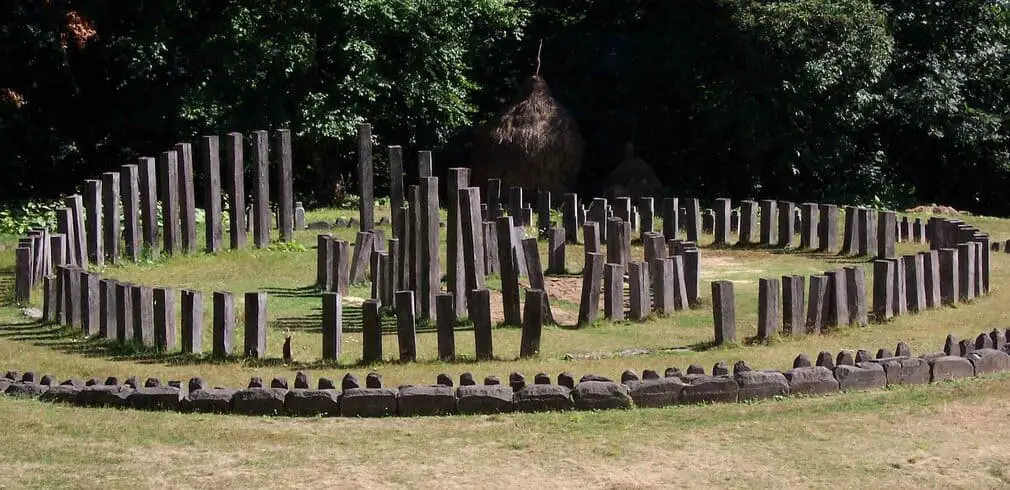
History of Sarmizegetusa Regia
The Dacian Civilization
Ever fancied a rendezvous with a culture so profound that its echoes still reverberate through time? Enter the world of the Dacians. Not just any civilization, the Dacians were a tapestry of fierce warriors, astute thinkers, and unparalleled craftsmen.
Picture this: majestic fortresses perched on hilltops, golden artifacts that shimmered in their splendor, and spiritual sanctuaries that resonated with cosmic energies. That was Dacia, a kingdom where valiance met artistry.
As you stride through Sarmizegetusa Regia, imagine the Dacians’ bustling life. Envision festivals where music filled the air, ceremonies where the gods were invoked, and marketplaces echoing with the clamor of trade and barter. Every pebble, every ancient remnant, paints a vivid picture of a civilization steeped in mystery and allure.
Battle of Sarmizegetusa
And then came the epochal moment: the Battle of Sarmizegetusa. It wasn’t just a clash of arms—it was an encounter between two titans, the Dacians and the Romans. On one side, the resilience and spirit of the Dacians, and on the other, the strategic brilliance and might of the Romans. As tales go, this wasn’t merely about victory or defeat. It was an epoch where fate was sealed, destinies were altered, and history was written in bold strokes.
The air of Sarmizegetusa still carries whispers of that grand confrontation. Stand still, and you might just hear the echoes of battle cries, the clang of weaponry, and the poignant songs of heroes and martyrs.
Post-Battle: The Roman Era and Beyond
But, oh, the story doesn’t end with the battle. It transforms. The aftermath saw the merging of two worlds. Roman architecture started dotting the Dacian landscape, while Dacian traditions found their way into Roman ethos. This melange brought forth a kaleidoscope of experiences—baths reminiscent of Roman luxury, sanctuaries still echoing with Dacian prayers, and art that spoke of both love and conquest.
Every monument, every artifact in Sarmizegetusa post-battle, is a testament to resilience, adaptation, and the eternal dance of cultures. In this historical tapestry, threads of joy, sorrow, victory, and loss are intricately woven together, waiting for the keen-eyed traveler to unravel them.
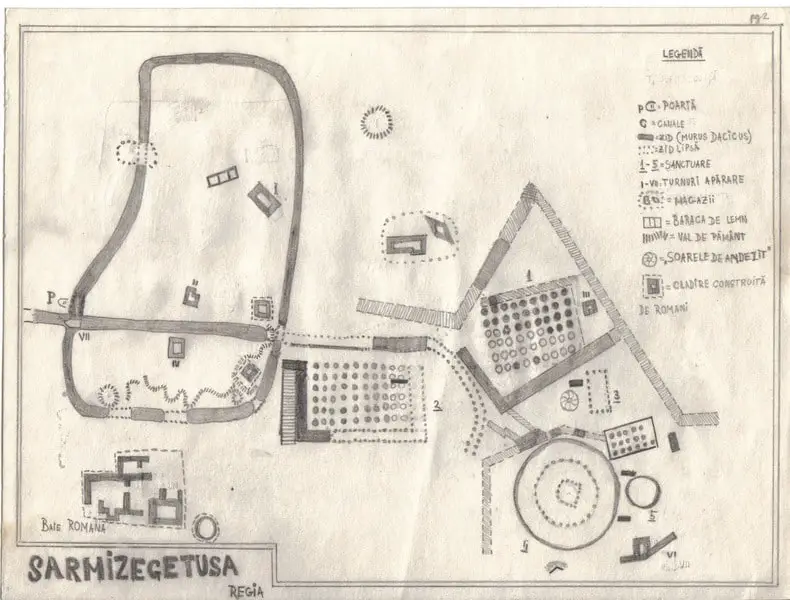
Exploring Sarmizegetusa Regia
Sarmizegetusa Map & Layout
Have you ever held a treasure map, your heart racing with the thrill of discovery, every curve and mark hinting at secrets waiting to be unearthed? Exploring Sarmizegetusa Regia feels eerily similar. Each trail, each marked location is a puzzle piece of the grand jigsaw that was once the thriving heart of Dacia.
As you wander through, the layout unfolds like a storybook. The ceremonial sanctuaries, the Dacian dwellings, the remnants of sophisticated water supply systems—they all come together to form a picture of an advanced civilization ahead of its time. The magic lies not just in seeing but in connecting the dots, in weaving together the tales that each section tells. So, when you hold that Sarmizegetusa map, know that you’re holding the key to countless stories of a bygone era.
Sarmizegetusa Reconstruction
If time travel were ever to be a reality, the closest we’d come to it today is the stunning 3D-imagined reconstruction of Sarmizegetusa Regia. It’s a treat for the senses, akin to a director’s cut of a film – only this film unfolds over centuries.
Imagine, a space where the modern world melds seamlessly with ancient history. The 3D reconstruction video takes us on a spellbinding journey, breathing life into the stones and ruins. With the magic of technology, walls rise, voices echo, and the Dacian citadel stands in all its grandeur once again.
Key Attractions & Significance
Within the sprawling expanse of Sarmizegetusa Regia, certain spots beckon with a luminous allure. These key attractions aren’t just physical structures but emotional epicenters where the heartbeats of countless Dacians are felt most potently.
The Great Circular Sanctuary, for instance, isn’t merely a series of concentric circles—it’s a cosmic portal, a place where the Dacians felt closest to the gods. The towers and fortifications stand not just as architectural marvels but as symbols of a kingdom’s might and resolve.
But it’s not all solemn history. The beauty of these attractions lies in the surprises they hold. A mysterious inscription here, an intriguing artifact there—each waiting to tickle your curiosity and coax out the detective in you.
So, as you hop from one attraction to the next, let go of mere sightseeing. Embrace the adventure, the wonder, and the sheer magic that Sarmizegetusa Regia showers upon its visitors. After all, it’s not just a historic site; it’s an emotion, a time capsule, a spell that transcends time.
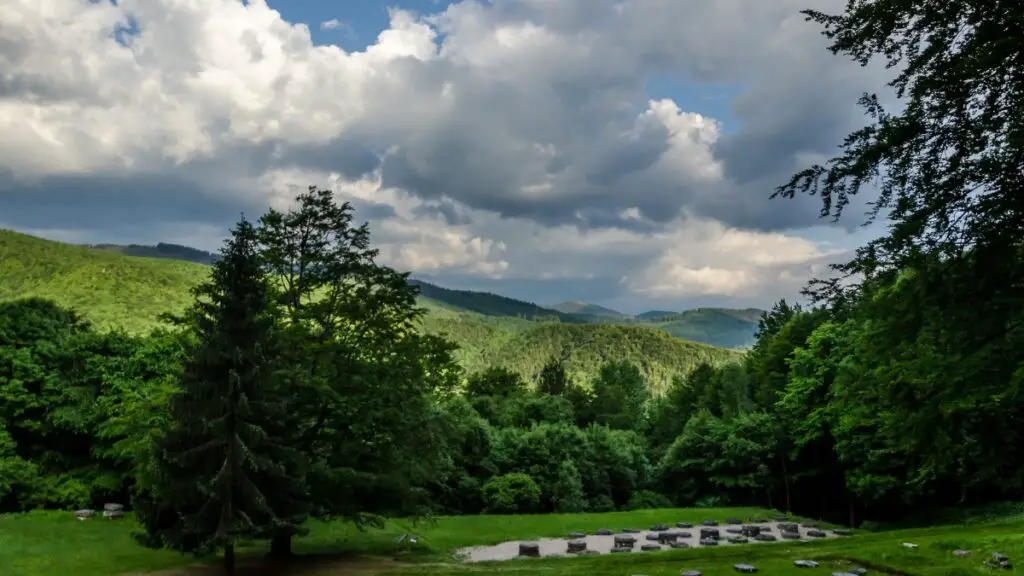
How to Get to Sarmizegetusa Regia
Embarking on a voyage to Sarmizegetusa Regia is like turning the pages of a fantasy novel – with each chapter more captivating than the last. Here’s your guide to reaching this historical masterpiece from notable locations:
From Bucharest to Sarmizegetusa Regia
Distance: Approximately 280 km
Driving Time: Around 5-6 hours
By Car: A scenic drive through Romania’s heartland, passing through picturesque landscapes and charming towns.
Public Transport: Trains are available to Simeria, followed by a bus to Hateg and then a taxi to the site. Note: It’s a longer journey, but a great way to immerse in the local culture.
From Hunedoara to Sarmizegetusa Regia
Distance: About 40 km
Driving Time: Roughly 1 hour
By Car: A relatively short journey that takes you through verdant meadows with the Carpathians on the horizon.
Public Transport: Buses operate between Hunedoara and Hateg. From Hateg, you can hire a taxi or catch a local bus during peak seasons.
From Cluj-Napoca to Sarmizegetusa Regia
Distance: Approximately 160 km
Driving Time: Around 3-3.5 hours
By Car: Drive south, soaking in the views of Transylvanian highlands and rustic hamlets.
Public Transport: Trains connect Cluj-Napoca to Simeria. From there, you can take a bus to Hateg and then a taxi to Sarmizegetusa Regia.
From Brașov to Sarmizegetusa Regia
Distance: Roughly 230 km
Driving Time: About 4-5 hours
By Car: Traverse through a tapestry of landscapes, from forested areas to open countrysides.
Public Transport: While there’s no direct train, one can reach Simeria via connecting trains and then follow the same route from Simeria as mentioned earlier.
From Sibiu to Sarmizegetusa Regia
Distance: Nearly 150 km
Driving Time: Approximately 3 hours
By Car: Traverse through the mesmerizing Transylvanian backdrop, with every mile narrating a tale.
Public Transport: Although there isn’t a direct public transport route, one can travel by train to Simeria and then transition to the bus-taxis combo to Sarmizegetusa Regia.
When venturing towards Sarmizegetusa Regia, let the journey be a part of the adventure. Whether you choose the independence of a car or the charm of public transport, the roads of Transylvania promise tales at every turn, setting the perfect prelude to the historical symphony that awaits. Safe travels!
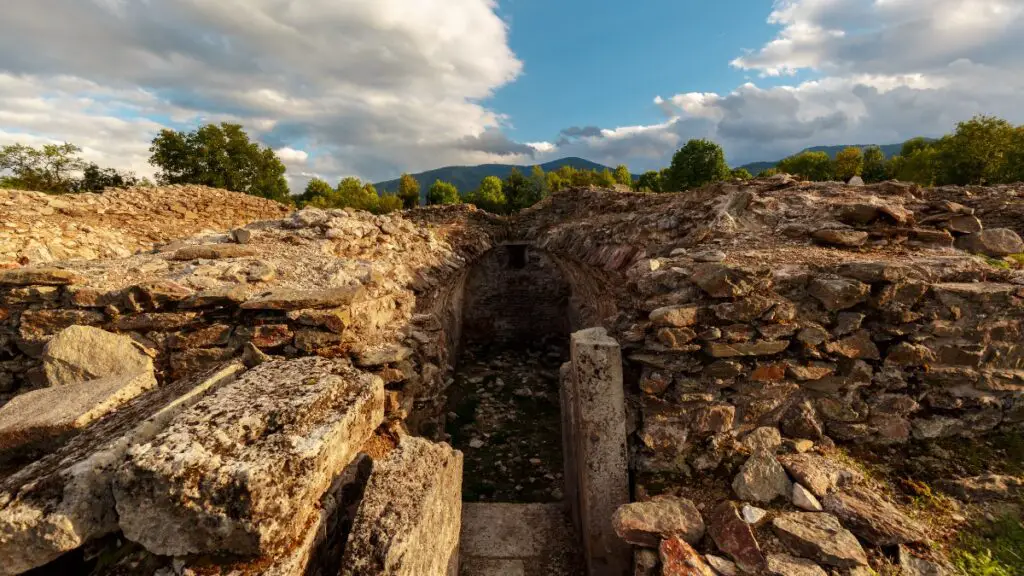
Tips for the Journey
Transylvania, with its myriad wonders, can sometimes be overwhelming for the unprepared traveler. So here’s a tiny treasure trove of tips to make your odyssey to Sarmizegetusa Regia smooth and enchanting:
Best Time to Visit: Embrace the magic of spring or the golden hues of autumn. These seasons drape Sarmizegetusa in ethereal beauty. Summer can be overcrowded with tourists and winter may be too cold to fully explore and appreciate the Dacian ruins.
Ticket Intel: Always check the current ticket prices and opening hours before you set forth. A little planning goes a long way in ensuring uninterrupted exploration.
Gear Up: The site demands a fair bit of walking. Comfortable shoes and some water? Non-negotiable!
As you weave through Transylvania’s roads, let the journey be as mesmerizing as the destination. After all, Sarmizegetusa isn’t just a place—it’s an epoch, a story, a whisper from the ages gone by. And getting there? That’s the prologue to your own epic tale.
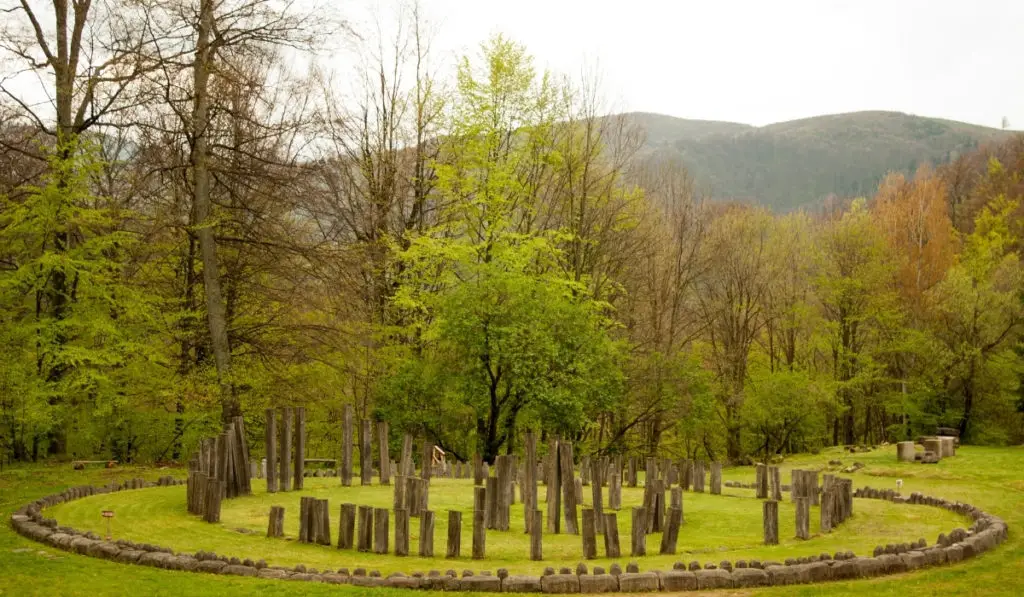
Experiencing Sarmizegetusa Regia
Immersing in the Aura
You know those places that don’t just offer a visual treat but also serenade the soul? Sarmizegetusa Regia is that kind of enchantress. As you tread its grounds, you’re not just a visitor; you’re an honorary Dacian, albeit momentarily. The winds seem to murmur ancient chants, the ruins pulsate with stories, and every step feels like a dance with history.
Feel the grass beneath your feet, let the sun kiss your cheeks, and as you close your eyes, let the world of the Dacians envelop you. This isn’t just about sightseeing—it’s an embrace, a deep dive into a realm where reality intertwines with legends.
The Panoramic Views: A Visual Delight
As if the historical allure wasn’t enough, Sarmizegetusa Regia playfully teases with panoramic views that can make even the most seasoned traveler’s heart skip a beat. Picture this: rugged mountains playing hide and seek with the clouds, dense forests stretching as far as the eye can see, and in the midst of it all, an ancient citadel standing tall, narrating tales of glory.
Grab that camera, find your perfect vantage point, and capture moments where nature and history waltz in perfect harmony. But hey, don’t forget to take a moment, set the gadgets aside, and soak in the raw and unfiltered view. It’s therapeutic, almost magical!
Interactive Sessions: Reliving the Dacian Life
Want to amp up the fun? Dive into interactive sessions that Sarmizegetusa Regia occasionally hosts. From pottery workshops reminiscent of Dacian craftsmanship to archery sessions echoing the valor of ancient warriors, it’s not just about learning—it’s about living the Dacian way, even if just for a few hours. Don the hat of an archaeologist, wield a bow, or mold clay—the choice is yours, but the thrill is guaranteed.
Local Delicacies: A Gastronomic Journey
And as the age-old saying goes (or at least, it should be one), “When in Dacia, eat as the Dacians did!” The vicinity of Sarmizegetusa Regia boasts eateries that serve dishes inspired by ancient recipes. Think hearty stews, fresh-off-the-farm produce, and brews that would make even a Dacian noble nod in approval.
It’s not just food; it’s a palette of flavors, each telling tales of the land, the people, and their rich heritage. Whether you’re nibbling on a snack or indulging in a full-fledged meal, each bite is a journey, a delightful rollercoaster of tastes and textures.
In the grand tapestry of Transylvania, Sarmizegetusa Regia is that dazzling gem that sparkles with an unmatched brilliance. Whether you’re chasing history, nature’s wonders, or simply the joy of discovery, this ancient citadel promises a myriad of experiences, each more enchanting than the last. So, tie those laces, ignite that wanderlust, and let Sarmizegetusa take you on an expedition that transcends time, space, and, quite possibly, imagination!
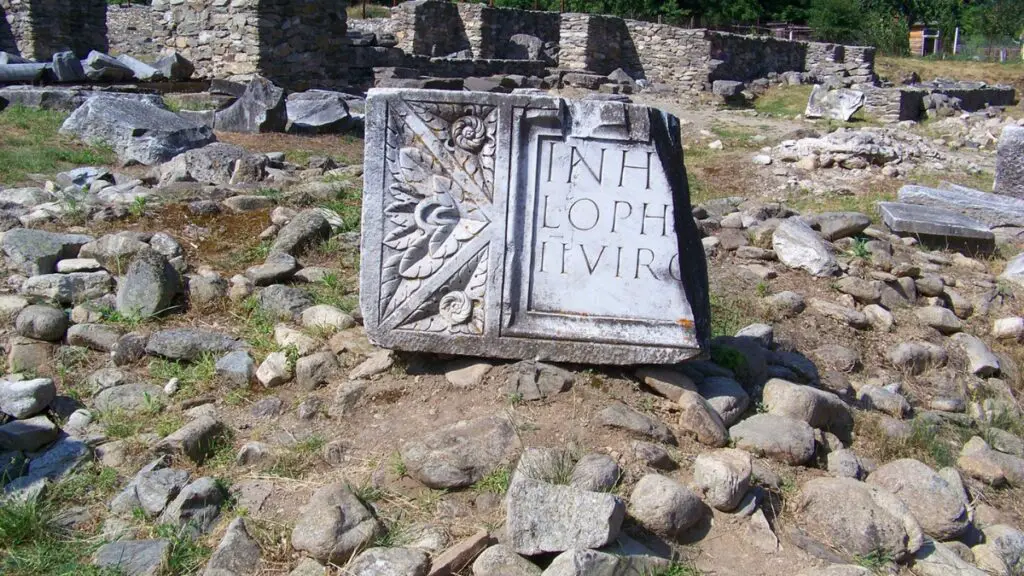
Concluding Your Journey at Sarmizegetusa Regia
Reflections & Echoes from the Past
As the sun begins to cast long shadows over the ancient stones and the day draws to a close, there’s an undeniable urge to pause and reflect. Standing amidst the remnants of a civilization that once thrived, it’s impossible not to feel the weight of time, the ebb and flow of history, and the resonating echoes of lives once lived.
Were they so different, these Dacians? As you imagine their laughter, their struggles, their rituals, and their dreams, you might find that the gap of millennia narrows, bridged by the shared human experience. The walls whisper, the ground reverberates, and for a fleeting moment, the veil between the past and the present feels tantalizingly thin.
Gifts & Souvenirs: Taking a Piece of History Home
Can one ever leave a place like Sarmizegetusa Regia without yearning for a tangible memory? Fortunately, the local artisans understand this wanderer’s heartache. From meticulously crafted jewelry inspired by Dacian designs to books that delve into the mysteries of this ancient civilization, the local souvenir shops are treasure troves for those wanting to hold onto a piece of their journey.
Whether it’s a pendant that you wear close to your heart, a postcard that graces your living room, or a book that finds its place on your bedside table, each item isn’t just an object—it’s a fragment of a story, a piece of Sarmizegetusa’s soul.
But whatever you do, don’t take any ancient artifacts from the site itself. You’ll find yourself in heaps of trouble with the local authorities.
Farewell, But Not Goodbye
As you prepare to leave, gazing one last time at the sprawling ruins, the ethereal mountains, and the horizon tinged with the hues of twilight, there’s a promise that hangs in the air—a promise of return. For places like Sarmizegetusa Regia aren’t merely destinations; they’re calls to the soul, beckoning again and again.
With memories etched deep and emotions running high, you’ll step out of the citadel’s embrace. But as the whimsical Transylvania unfolds before you once more, with its myriad tales and wonders, you’ll carry with you a secret—a piece of Sarmizegetusa, forever etched in the annals of your heart.
And thus, as the tapestry of history, nature, and adventure weaves its spell, Sarmizegetusa Regia stands as a testament to the beauty of discovery, the thrill of exploration, and the timeless tales that spaces can hold. A jewel in Transylvania’s crown, it beckons to all—calling out to the wanderer, the historian, the dreamer. Will you answer its call again? Only time, and the winds of Transylvania, will tell.

